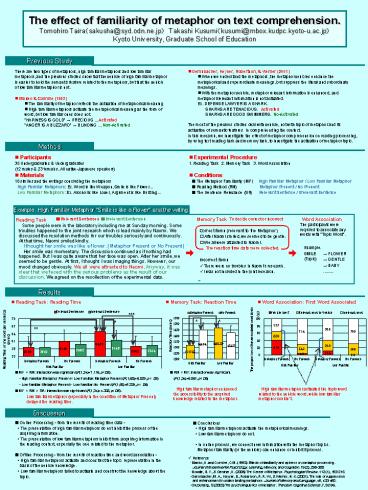Previous Study - PowerPoint PPT Presentation
1 / 1
Title:
Previous Study
Description:
The effect of familiarity of metaphor on text comprehension. Tomohiro Taira sakusha_at_syd.odn.ne.jp Takashi Kusumi kusumi_at_mbox.kudpc.kyoto-u.ac.jp – PowerPoint PPT presentation
Number of Views:52
Avg rating:3.0/5.0
Title: Previous Study
1
The effect of familiarity of metaphor on text
comprehension. Tomohiro Taira(sakusha_at_syd.odn.ne.j
p) Takashi Kusumi(kusumi_at_mbox.kudpc.kyoto-u.ac.jp)
Kyoto University, Graduate School of Education
Previous Study
- There are two types of metaphors, high familiar
metaphors and low familiar metaphors, and the
previous studies show that the vehicle of high
familiar metaphor is easier to hold the semantic
feature related to the metaphors, but that the
vehicle of low familiar metaphor is not. - Blasko Connine (1993)
- The familiarity of metaphor reflects the
activation of metaphorical meaning - High familiar metaphors activate the
metaphorical meaning as the form of word, but low
familiar ones does not. - HAPINESS IS GOLD ? PRECIOUS ... Activated
- ANGER IS A BLIZZARD ? BLINDING ...
Non-Activated
- Gernsbacher, Keyser, Robertson, Werner (2001)
- When we understand the metaphors, the metaphor
vehicles enhance the metaphorical and
superordinate meanings, but suppress the literal
and subordinate meanings. - With the metaphor vehicle, metaphor relevant
information is enhanced, and metaphor irrelevant
information is not activated. - Ex. DEFENSE LAWYER IS A SHARK.
- SHARKS ARE TENACIOUS. Activated
- SHARKS ARE GOOD SWIMMERS. No-Activated
The most of the previous studies deal with
vehicle, not with topic of metaphor and its
activation of semantic features in comprehending
the context. In this research, we investigate
the effect of metaphor comprehension on reading
processing, by using text reading task and memory
task, to investigate the activation of metaphor
topic.
Method
- Participants
- 35 Undergraduates Undergraduates
- (12 males 23 females, All native-Japanese
speakers) - Materials
- 16 similes and the writings concluding the
metaphors - High Familiar Metaphors Ex. Word is like
Weapon, Smile is like Flower... - Low Familiar Metaphors Ex. Alcohol is like
Lover, Argument is like Building...
- Experimental Procedure
- 1. Reading Task 2. Memory Task 3. Word
Association - Conditions
- The Metaphor Familiarity (MF) High Familiar
Metaphor / Low Familiar Metaphor - Reading Method (RM) Metaphor Present
/ No Present - The Sentence Relevance (SR) Relevant
Sentence / Irrelevant Sentence
Example. High Familiar Metaphor Smile is like a
Flower and the writing
Relevant Sentences Irrelevant Sentences
To decide correct or incorrect
Reading Task
Memory Task
Word Association
The participants were required to associate any
words with Topic Word.
Some people were in the laboratory including me
at Sunday morning. Some troubles happened to the
joint research which is lead mainly by Naomi. We
discussed the resolution methods for our troubles
seriously and continuously. At that time, Naomi
smiled kindly. I thought her smile was like a
flower. (Metaphor Present or No Present) Her
smile was momentary. The discussion continued as
if nothing had happened. But I was quite aware
that her face was open. After her smile, we
seemed to be gentle. At first, I thought I was
imaging things. However, our mood changed
obviously. We all were attracted to Naomi.
Anyway, it was clear that we faced with the
serious problems as the result of our discussion.
We agreed on the recollection of the experimental
data.
- Correct Items (relevant to the Metaphor)
- After Naomi smiled, we seemed to be gentle.
- We all were attracted to Naomi.
- Incorrect Items
- There were no troubles in Naomis research.
- I was not included in the joint research.
Example.
The reaction time data were collected.
SMILE (Topic)
? FLOWER
? GENTLE
? BABY
.........
Results
- Reading Task Reading Time
- Memory Task Reaction Time
- Word Association First Word Associated
()
Reaction Time (msec)
Reading Time of one word per sentence (msec)
The proportion of the associated word kinds
MF RM Interaction was significant
(F(1,34)7.116, plt.05). - High Familiar
Metaphor Present lt Low Familiar Metaphor Present
(F(1,68)6.029, p lt .05) - Low Familiar
Metaphor Present gt Low Familiar No Present
(F(1,68)5.339, p lt .05) MF RM SR
Interaction was significant (F(1,34)4.308,
plt.05).
RM MF Interaction was significant.
(F(1,34)6.861, plt.05)
High familiar metaphor enhanced the
accessibility to the acquired knowledge related
to the metaphor.
High familiar metaphor activated the topic word
related to the vehicle word, while low familiar
metaphor couldnt.
Low familiar metaphor (especially in the
condition of Metaphor Present) delayed the
reading time.
Discussion
Online Processing - from the results of reading
time data - The presentation of high familiar
metaphors do not inhibit the process of the
acquiring information. The presentation of low
familiar metaphors inhibit from acquiring
information in the reading context, especially
the one related to the metaphor. Offline
Processing - from the results of reaction time
and word association - High familiar metaphors
activate and construct the topic representation
in the basis of the vehicle knowledge. Low
familiar metaphors failed to activate and
construct the knowledge about the topic.
Conclusions High familiar metaphors activate
the metaphorical meanings. Low familiar
metaphors do not. In online process, we
connect new information with the metaphor topics.
Metaphor familiarity (or the vehicle) can enhance
or inhibit it process.
- Reference
- Blasko, D. and Connine, C.M. (1993) Effects of
familiarity and aptness on metaphor processing.
Journal of Experimental Psychology. Learning,
Memory, and Cognition. 19 (2), 295-308 - Bowdle, B. F., Gentner, D. (2005) The Career
of Metaphor. Psychological Review. 112 (1),
193-216 - Gernsbacher, M. A., Keyser, B., Robertson, R.
R. W., Werner, N. K. (2001). The role of
suppression and enhancement in understanding
metaphors. Journal of Memory and Language, 45,
433-450. - Glucksberg, S.(2003) The psycholinguistics of
metaphor. Trends in Cognitive Science, 7, 92-96.































